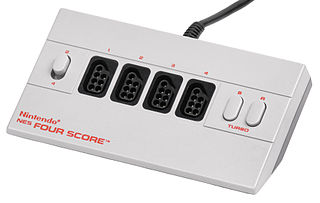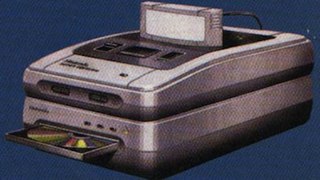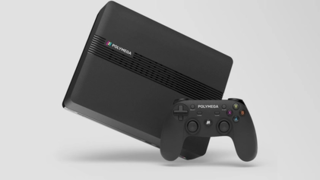
The Super Nintendo Entertainment System, commonly shortened to Super Nintendo, Super NES or SNES, is a 16-bit home video game console developed by Nintendo that was released in 1990 in Japan and South Korea, 1991 in North America, 1992 in Europe and Oceania and 1993 in South America. In Japan, it is called the Super Famicom (SFC). In South Korea, it is called the Super Comboy and was distributed by Hyundai Electronics. The system was released in Brazil on August 30, 1993, by Playtronic. Although each version is essentially the same, several forms of regional lockout prevent cartridges for one version from being used in other versions.

The NES Four Score is a multitap accessory created by Nintendo in 1990 for the Nintendo Entertainment System. Select games can utilize it to enable up to four-player gameplay. The NES Four Score is similar to the previously introduced NES Satellite, a device that allows four players to connect to the NES and extends the range using infrared wireless communication.
In video gaming, famiclone is a term used to refer to a hardware clone of the Nintendo Entertainment System (NES), known in Japan as the Family Computer or Famicom. They are designed to replicate the workings of, and play games designed for, the NES and Famicom. Hundreds of unauthorized clones and unlicensed game copies have been made available since the height of the NES popularity in the late 1980s. The technology employed in such clones has evolved over the years: while the earliest clones feature a printed circuit board containing custom or third party integrated circuits (ICs), more recent (post-1996) clones utilize single-chip designs, with a custom ASIC which simulates the functionality of the original hardware, and often includes one or more on-board games. Most devices originate in China and Taiwan, and less commonly South Korea. Outside China and Taiwan, they are mostly widespread across emerging markets of developing countries.

The Super FX is a coprocessor on the Graphics Support Unit (GSU) added to select Super Nintendo Entertainment System (SNES) video game cartridges, primarily to facilitate advanced 2D and 3D graphics. The Super FX chip was designed by Argonaut Games, who also co-developed the 3D space rail shooter video game Star Fox with Nintendo to demonstrate the additional polygon rendering capabilities that the chip had introduced to the SNES.

The Atari Flashback series are a line of dedicated video game consoles designed, produced, published and marketed by AtGames under license from Atari SA. The Flashback consoles are "plug-and-play" versions of the Atari 2600 console. They contain built-in games rather than using the ROM cartridges utilized by the 2600. Most of the games are classics that were previously released for the 2600, although some Flashback consoles include previously unreleased prototype games as well.

The Classic Controller is a game controller produced by Nintendo for the Wii home video game console. While it later featured some compatibility with the Wii U console, the controller was ultimately succeeded by the Wii U Pro Controller. In April 2014, Nintendo discontinued production of both the Classic Controller and Classic Controller Pro.

Rendering Ranger: R2 is a 1995 side scrolling action video game developed by Rainbow Arts and published by Virgin Interactive for the Super Famicom. It was released only in Japan, and has gone on to be one of the rarest Super Famicom titles in existence. In June 2022, Ziggurat Interactive announced that the game would be ported to Microsoft Windows, Nintendo Switch, PlayStation 4, and PlayStation 5, with Limited Run Games set to distribute physical copies for the Super Nintendo Entertainment System.

The Nintendo Entertainment System (NES) is an 8-bit third-generation home video game console produced by Nintendo. It was first released in Japan in 1983 as the Family Computer (FC), commonly referred to as Famicom. It was redesigned to become the NES, which was released in American test markets on October 18, 1985, and was soon fully launched in North America and other regions.

The Super NES CD-ROM is an unreleased add-on for the Super Nintendo Entertainment System (SNES) video game console. It was built upon the functionality of the cartridge-based SNES by adding support for a CD-ROM-based format known as Super Disc.
RetroN is a series of video game consoles created and developed by Hyperkin which allows users to play video games from consoles such as the Nintendo Entertainment System and the Super NES. Since the release of the RetroN 5, they have been connected via HDMI. The latest in the series, RetroN Sq, was released in 2021.

NES Classic Edition is a dedicated home video game console by Nintendo, that emulates the Nintendo Entertainment System (NES) and Family Computer (Famicom). It launched on November 10, 2016, in Australia and Japan, and November 11, 2016, in North America and Europe. Aesthetically, the console is a miniature replica of the NES, and it includes a static library of 30 built-in games from the licensed NES library, supporting save states for all of them.
The Analogue Nt is a home video game console designed and manufactured by Analogue, designed to play games for the Nintendo Entertainment System and the Famicom.
The Analogue Nt Mini is a video game console designed and manufactured by Analogue It was designed to play games for the Nintendo Entertainment System and the Famicom, like the original Analogue Nt. Unlike the former, the Nt Mini uses an FPGA for processing.

The Super NES Classic Edition is a dedicated home video game console released by Nintendo, which emulates the Super Nintendo Entertainment System. The console, a successor to the NES Classic Edition, comes with twenty-one Super NES titles pre-installed, including the first official release of Star Fox 2. It was released in North America and Europe on September 29, 2017.

Hyperkin is an American video game peripheral manufacturer and distributor, founded in 2006, based in Los Angeles, California. They distribute accessories for major gaming consoles, in addition to creating clone consoles that play retro games with modern resolutions and on modern devices, most notably the RetroN series of clone consoles. As with most other NES clones, Hyperkin's NES clones suffer from imperfect sound due to a design flaw in the sound hardware.
Kevin "Kevtris" Horton is an American electrical engineer known for his work with Analogue with the Analogue Nt Mini, Super Nt, and the Mega Sg.

The Mega Sg is a home video game console manufactured by Analogue, released in 2019. It runs games developed for the Sega Genesis, Master System, Game Gear and SG-1000, systems released by Sega in the 1980s and early 1990s during the fourth generation of consoles. Rather than emulate games, the Mega Sg uses FPGA chips that replicate the original system hardware.

The Nintendo Entertainment System (NES), an 8-bit third-generation home video game console produced by Nintendo, had numerous model variants produced throughout its lifetime. It was originally released in 1983 as the Family Computer in Japan, with design work led by Masayuki Uemura. Nintendo intentionally redesigned it as the NES in North America in an attempt to avoid the stigma of video game consoles lingering from the video game crash the same year; while it was initially conceptualized as a home computer, it was ultimately modeled after a videocassette recorder (VCR) for its debut there in 1985. Nintendo subsequently exported the NES to Europe and Oceania via local distributors.

Polymega is a home video game console developed by American company Playmaji, Inc. It is a retro gaming console offering backwards compatibility with several CD-based and cartridge-based platforms: PlayStation, TurboGrafx-CD, Neo Geo CD, Sega CD, Sega Saturn, Nintendo Entertainment System (NES), Sega Genesis, Sega 32X, Super Nintendo Entertainment System (SNES), and Nintendo 64. It includes a built-in CD drive, while separate add-ons known as Element Modules provide support for cartridge-based games.














